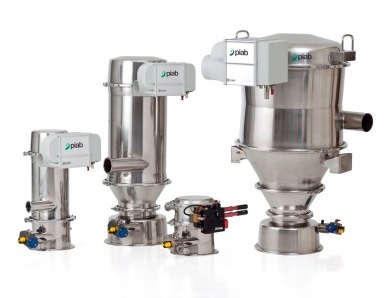Dimensioning a Conveying System for Bulk Materials
December 17, 2014

Are you considering installing a new vacuum conveying system for the handling of granular bulk materials? Well, then you first need to answer this checklist of questions. The designer of your system requires answers to these in order to dimension, design, and finally assemble a materials handling system that suits your particular application.
1. What Material?
The material is the key. Your designer needs to know the bulk density of the material; i.e. how much it weighs in kilograms per liter (kg/l). It is also important to establish an approximate size for individual particles in the material, measured in micrometers (µm).
Determining how sticky the material is requires a more hands-on approach. Stickiness, or fluidity as it is more correctly referred to, is different from other parameters in that it is difficult to measure; hence there is no single unit or test to apply.
However, there are methods that will help determine the fluidity. First, there is the angle of repose. This is the internal angle of the conical pile, formed when a material is poured onto a horizontal surface. It represents the steepest angle of descent relative to the horizontal plane to which a granular material can be piled without slumping. This means that the material on the slope is on the verge of sliding at this angle.
The angle of repose is dependent on the density and the coefficient of friction of the material, as well as the surface area and the shape of individual particles. However, it has also been shown to be gravity-dependent. Nevertheless, it provides a guide for how the material will perform when handled in a conveying system.
Next, there is the “squeezing-it-in-your-hand” test. This involves squeezing a handful of the material in the palm of your hand. Some materials, for instance milk powder, will form a ridge in the hand, whereas others, such as granulated sugar, will not. If, in the next step, the ridge stays intact when prodded, your designer might need to include functionality to improve the fluidity.
However, as a rule of thumb, any material that forms a ridge which falls apart when prodded, as milk powder would, can be handled by standard equipment.
2. How Clean?
In order to choose the right type of equipment for the conveying system, the designer also needs to know what their client requires in terms of cleanliness of the transported material. It goes without saying that a mining company, a manufacturer of foodstuff, and a pharmaceutical industry have very different perspectives on cleanliness. Therefore, conveyor systems are often offered in different designs targeted at specific industries or purposes. However, there may be special circumstances in which the norms or standards need to be adjusted to suit a specific application.
3. How Far?
Spatial data regarding the transportation system itself is also vital. The designer has to know how far the material needs to be transported. However, simply measuring the distance in meters is not enough. Accurate measurements for horizontal versus vertical distances are necessary as these will greatly impact the design of the system.
The transportation route will determine the number of pipe bends needed in the system, and this will in turn influence the choice of vacuum pump used in the system. For vertical lifts, a rule of thumb is that any material can be transported eight meters straight up without any particular problem.
However, lifting beyond eight meters may require installation of a pipe emptying unit towards the end of the vertical pipe. Such units use air to help “push” the material further along the pipe. A conveying system equipped with a pipe emptying unit can transport materials vertically up to 25 meters.
4. What Capacity?
The capacity, throughput, or flow rate of the system is next on the designer’s list of questions. The capacity is measured in tons per hour and, together with the respective vertical and horizontal distances, it provides the designer with a figure that is used to select a pump for the system.
The material’s bulk density will also help determine the dimensions of the pipes used in the system in order to achieve the required capacity. The size of the individual particles will determine which type of filter is needed.
5. Any Risks?
To avoid dust explosions, specialized equipment may be required for materials prone to developing static electricity. Compliance with industrial standards included in regulations such as the EU ATEX Directive is an essential part of the design work.
High pressure and high temperature are other potential risk factors that might need to be considered. Examples include overpressure in connecting equipment, and heat sources that increase the temperature near the conveyor. However, these problems are usually relatively easily overcome by using equipment of the right specifications.
6. Test It?
An experienced designer will have no problem dimensioning and building a vacuum-based conveying system for common materials. However, faced with unfamiliar materials or perhaps extreme spatial constraints, the designer may decide to test the system in-house before it is implemented at the client’s premises. Having access to such test facilities is a clear advantage, as well as reassuring for clients.
Getting it Right
Having ticked off all the questions on the checklist, the designer is ready to set to work building a system fit for purpose. Furnished with all the necessary information regarding: the fluidity, bulk density, and particle size of the material; the horizontal and vertical distances in the available space; the desired capacity; any special requirements concerning cleanliness or potential risks; and results from a potential trial run, the designer can choose the right vacuum conveyor for the job.
Tomas Dahl is strategic sales OEM, Material Handling Div. Piab AB. Piab develops and manufactures a complete line of vacuum pumps, vacuum accessories, vacuum conveyors, and suction cups. For more information, visit www.piab.com.
For related articles, news, and equipment reviews, visit our Pneumatic Conveying Equipment Zone
You May Also Like


